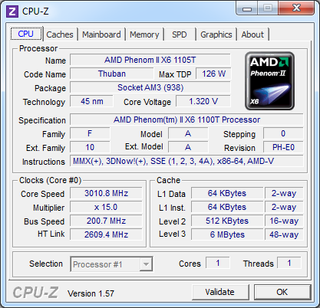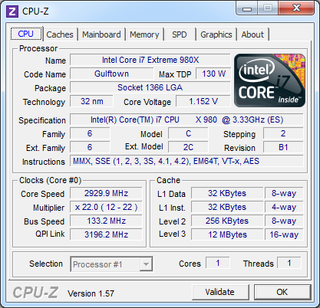Tom's CPU Architecture Shootout: 16 CPUs, One Core Each, And 3 GHz
The CPU landscape is really complex. Both AMD and Intel offer tons of different models. But how would today’s processors perform if they didn't have multiple cores? We take 16 different CPUs and compare them all using a single core running at 3 GHz.
Six-Core CPUs: AMD Thuban And Intel Gulftown
AMD Thuban, 45 nm (Phenom II X6, Rev. E0)

We're using an AMD Phenom II X6 1100T processor based on the E0 stepping. It supports AMD's most recent feature set, including Turbo Core and Cool'n'Quiet. Both technologies were switched off for our tests in order to guarantee a constant 3.0 GHz (though the 1100T runs at 3.3 GHz by default). It boasts 512 KB of L2 cache per core and a 6 MB shared L3 cache. A 45 nm manufacturing process allows this processor to operate at a 125 W thermal design power, and a dual-channel DDR3 memory controller supports modules at up to 1333 MT/s.
Intel Gulftown, 32 nm (Core i7-980X, Rev. B1)

Intel’s 32 nm six-core configuration is referred to as Gulftown. We've seen it manifest as the Core i7-980X, -990X, and -970. We're using the 3.3 GHz -980X for this experiment, which we drop to 3 GHz by adjusting its multiplier down to 22x.
Despite the fact that the Sandy Bridge design is newer, this is still one of Intel's flagships, if only because of its six-core arrangement, 256 KB of L2 cache per core, and a large, shared 12 MB L3 cache. The downside is that Gulftown requires a more expensive LGA 1366-based platform with triple-channel DDR3 memory. This part is rated for a 130 W TDP.
Stay on the Cutting Edge
Join the experts who read Tom's Hardware for the inside track on enthusiast PC tech news — and have for over 25 years. We'll send breaking news and in-depth reviews of CPUs, GPUs, AI, maker hardware and more straight to your inbox.
Current page: Six-Core CPUs: AMD Thuban And Intel Gulftown
Prev Page A Real (Theoretical) Performance Shootout Next Page Modern Quad-Core CPUs: AMD Deneb And Intel Sandy BridgeMost Popular

